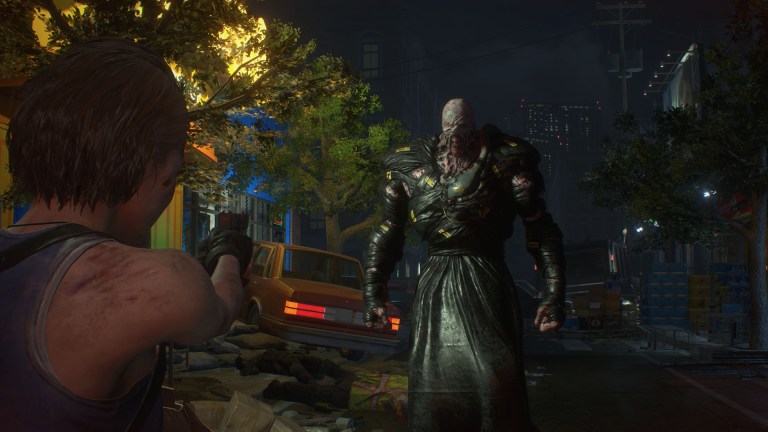Resident Evil 3 Review: An Unremarkable Remake
Does the controversial Resident Evil 3 make the most of its second chance? Read our review of the latest Resident Evil remake.

Resident Evil 3 begins with a small live-action sequence meant to show the impact of the zombie invasion on Racoon City. It explains how the spread of a deadly virus has forced the CDC to essentially put Racoon City on quarantine lockdown. All the while, we get the impression that confused citizens are trying to figure out what is happening as they try their best to avoid getting infected and infecting others.
It is, to say the least, a somewhat awkward setup in the age of the coronavirus. It’s not necessarily mean spirited or exploitative (that part of the story hasn’t changed much since the original game’s release in 1999) but it is a fascinating reminder of the situation we find ourselves in and how quickly things can change over the years. Sadly, it’s not the only way that the Resident Evil 3 remake reminds us of the game’s awkward place in the history of this stellar franchise.
The development of 1999’s Resident Evil 3: Nemesis was hindered by its ultimately limited scope. It was originally supposed to be helmed by Resident Evil 2 director Hideki Kamiya and was seen at that time by Capcom as the next major “mainline” Resident Evil title. That changed when the planned release date of the PlayStation 2 changed the company’s console development timeline and Kamiya was eventually tasked with planning Resident Evil 4. A slightly different team ended up developing Resident Evil 3, which was viewed internally as more of a spin-off.
Upon its release, many criticized Resident Evil 3 for its short length and relative lack of ambition in comparison to the revolutionary Resident Evil 2. Yet, for every criticism, there was praise for the things the game did do well and even some of the innovations it did introduce. Said innovations include the title’s more action-oriented nature and larger environments, as well as its brilliant implementation of the Nemesis as a kind of Terminator who hunts the player throughout their journey.
Fortunately, there are many ways that the Resident Evil 3 remake retains the qualities which elevated the original title above its humble spin-off origins.
Release Date: April 3, 2020
Platform: PlayStation 4 (Reviewed), Xbox One, PC
Developer: Capcom
Publisher: Capcom
Genre: Survival Horror
It starts with the gameplay. The Resident Evil 2 remake gave players much more control over the action than they had in the original version of that title, but it also emphasized survival elements that forced you to manage relatively limited resources. As such, you were often encouraged to treat action sequences similar to how you would have in the original title, which is to say that the game forced you to run from enemies quite often in order to preserve resources.
Resident Evil 3 is based on the same engine and gameplay that powered Resident Evil 2‘s remake, but there are some key differences. Even if you don’t choose the game’s “easy” mode and start with an assault rifle and other accommodations (which certainly changes the dynamic of the game’s opening hours), you’ll likely be shooting your way through more encounters in Resident Evil 3 than you would have in Resident Evil 2. Some sections are clearly designed with more of an action-oriented approach in mind, and most areas (especially those in the beginning) really sell the warzone scope of what is happening.
While some fans will undoubtedly prefer horror sequences and puzzle-solving (two elements which are still present in a sometimes slightly reduced capacity), there are two things that make this action approach work from a pure design perspective. The first is the craft of those aforementioned action sequences and how certain sections of the game are simply well-done, adrenaline-pumping examples of action/horror gaming. A particular scenario involving Carlos and an earlier one that sees Jill battle some spiders stand out as great examples of the benefits of the action game design.
Perhaps more importantly, Resident Evil 3 features expanded control options which allow our playable protagonists to more easily dodge incoming attacks. This feature is a welcome addition. Many encounters require you to dodge enemies in tight spaces in order to avoid death. Resident Evil 3 can be difficult, but mastery of the dodge system makes combat mostly manageable.
While I expected Resident Evil 3’s stellar blend of survival and action to translate well to this modern style of RE game design, I was surprised by how well the game’s story has held up over the years. Resident Evil 3’s plot, which occurs before, during, and after the events of Resident Evil 2, largely focuses on Jill Valentine as she attempts to escape Racoon City in the midst of the zombie apocalypse. Assisting her is fellow playable character Carlos Oliveira, who is part of a group of shady Umbrella-sponsored mercenaries sent to clean up the mess and carry out secret tasks. Directly standing in her way is an army of zombies as well as the infamous creature known as the Nemesis who exists to hunt and kill S.T.A.R.S members like herself.
It’s a small story in comparison to other Resident Evil epics, but that’s exactly what makes it work. It’s not bogged down by the sometimes bloated mythology of the Resident Evil series but uses that mythology in smart ways to enhance the stakes of what is happening and give everyone a meaningful part to play. It doesn’t hurt that the remake features some brilliant new content such as a stunning new early story sequence and some smart alterations designed to keep those who know the basic plot beats on their toes.
The game’s dialogue is pretty awful, but it’s awful to the point that you’ll eventually begin to appreciate it as a tribute to the corny dialogue of Resident Evil games of the past. It’s a little frustrating that the team couldn’t at least make Jill a more interesting character in this game but it’s not a deal-breaker by any means.
You’ve undoubtedly noticed that I’ve yet to mention the Nemesis in terms of the way that the Resident Evil 3 remake resurrects the best qualities of the original experience. Well, there are several reasons why this is the case.
For the most part, the Nemesis does his job in this game. He looks great, he offers plenty of jump scares, and it’s certainly still intimidating that he can pop up at any time while you’re wandering the city streets.
Unfortunately, that last part isn’t really true. Outside of the very early parts of the game where the presence of the Nemesis feels a little more dynamic (even if most of those sequences are scripted), you get to a point when you can feel the Nemesis is coming. When he does come for you, Resident Evil 3’s improved controls and more manageable camera naturally make him easier to deal with than he was in the original game.
Attempts were made to make the original encounters play out a bit differently, and while I won’t spoil the specifics here, none of them make his appearances feel more organic or make the fights against him that much more intimidating than they were in the original game. For that matter, he’s rarely as scary or interesting as Mr. X was in the Resident Evil 2 remake. Mechanically, that’s a problem, but the bigger issue is how the shortcomings of the Nemesis encounters really summarize how Resident Evil 3 is still sometimes treated like the tagalong sibling to Resident Evil 2.
The Resident Evil 2 remake was a dream project that surpassed many expectations. It looked stunningly beautiful, and it expertly blended the action elements of Resident Evil 4 with the survival aspects of the original titles. Most importantly, it gave fans old and new a fresh way to experience an all-time classic horror title.
Resident Evil 3 doesn’t offer that luxury. Its biggest problem is that the original game felt like a glorified expansion to Resident Evil 2, and all these years later, the remake kind of still does. It’s still a much shorter game than Resident Evil 2 (some have said they’ve beaten it in under 5 hours, but that could depend on difficulty settings), and because I wasn’t able to access the Project Resistance multiplayer mode during my time with the game, it’s hard to say how much value that adds to the purchase. All of the visual and mechanical novelties introduced in the Resident Evil 2 remake now feel expected, and even the game’s core mechanics (the threat of the Nemesis and the more action-focused gameplay) haven’t been properly expanded on in such a way that makes them feel unique.
Resident Evil 3 would have greatly benefited from the design philosophies that drove the brilliant remakes of the first two Resident Evil titles. Both of those games did a great job of acknowledging not only what made the originals work but what about them hadn’t aged well in the years since. They improved upon their legendary namesakes so thoroughly that you could easily consider them to be the definitive versions of those titles.
I suppose the same can be said of the Resident Evil 3 remake from an accessibility and technical standpoint, but some 20+ years after the original’s release, I’m still left with many of the same complaints and praises that most people had when they played the game in 1999. The original Resident Evil 3 may have suffered from a tight development cycle and shifts in creative direction, but in 2020, there’s no good reason that Capcom couldn’t have looked at the things that the original did so well and crafted a new experience to exemplify and expand upon those qualities.
It’s fine that Resident Evil 3 is essentially just more of the stellar Resident Evil 2 remake experience with a few twists and a new story to tell, but it’s sad to think that this remake may ultimately cement Resident Evil 3’s legacy as a fun, clever, and intriguing look at what might have been.

